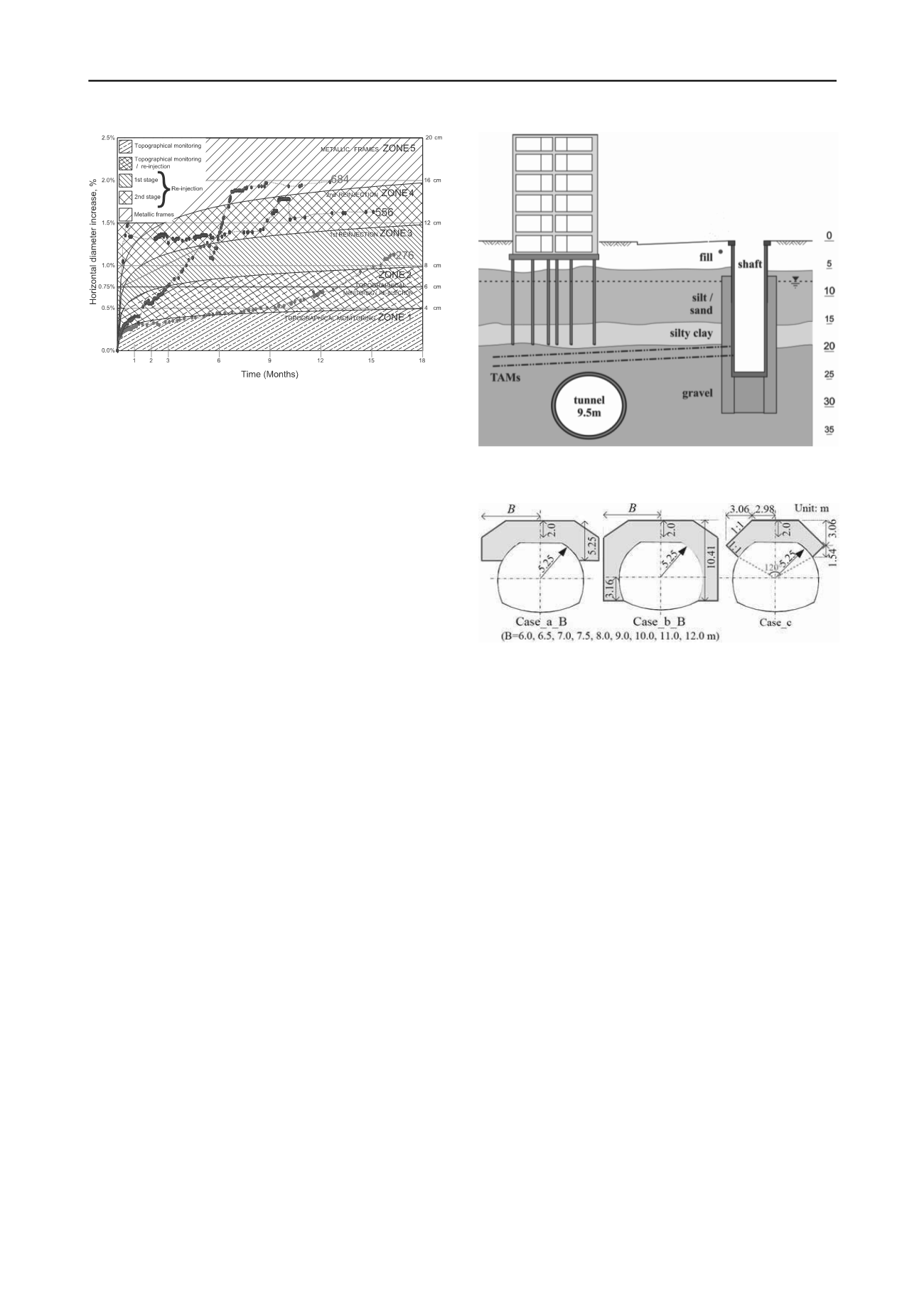
1676
Proceedings of the 18
th
International Conference on Soil Mechanics and Geotechnical Engineering, Paris 2013
Figure 8. Time evolution of the horizontal diameter of three different
ring sections over the proposed diagram for deformational control of
tunnel segments (modified from Aguilar
et al.
).
Fang
et al.
in their paper “Construction of a cross passage
between two MRT tunnels” defend the concept of several
defence measures against water inflow in tunnels under high
water head as the only reliable approach. They report the
construction of a cross passage between two shield tunnels for
the construction of Tu-chen Line of Taipei Rapid Transit
Systems. Both jet grouting and chemical grouting were
performed to ensure the construction safety under the 26.7 m of
pressure head acting on the site. Water-leak tests were
conducted, since any crack in the waterproofing system could
cause major losses in the project.
Kummerer and Sciotti
report how two compensation
grouting works were performed to mitigate TBM induced
settlements for structures founded on shallow and deep
foundations in Rome. Their paper “Compensation grouting with
shallow and deep foundations – case study from the metro B1 in
Rome” describes how a full scale field trial was performed, for
the piled foundation and the footing, in order to properly design
the real interventions. Shafts constructed with soilcrete jet-
grouting, for the lateral wall and the sealing slab, enabled the
TAMs (
Tubes a Manchette
, the tubes by which the grout is
injected) to be installed with Horizontal Directional Drilling
technology. Figure 9 shows a schematic cross section of one of
the buildings with a piled foundation close to Ionio Station with
a TAM to pile distance of only 1.65 m, as obtained from the
figure.
It was reported that no significant settlements were measured
during the drilling operations. The water tightness of the shaft
was assessed with pumping and thermal leakage tests, as the
water table was just a few meters below the surface. The
measured settlements were significantly below the tolerable
values and confirm the efficiency of the compensation grouting
technique both technically and economically both for shallow
and deep foundations.
Cui and Kishida
in their paper “Effect of pre-ground
improvement method during shallow NATM tunnel excavations
under unconsolidated conditions” analyse the layout of ground
improvement prior to tunnelling for shallow NATM tunnels in
Japan. This surface intervention creates a soil-cement mixture
above the tunnel crown. 2D FEA were performed based on the
t
ij
constitutive model and indicated that surface settlements can
be prevented by adopting the pre-ground improvement method,
and that the method becomes more effective as the improved
area becomes larger (Figure 10). The influenced area due to the
tunnel excavation becomes narrow as the reinforcement zone
intercepts the shear band generated by the tunnel excavation.
Figure 9. Schematic cross section for TAM installation close to a piled
foundation at ‘Ionio Station’ (after Kummerer and Sciotti).
Figure 10. Analysed patterns for the ground improvement profile (after
Cui and Kishida).
Ilyichev
et al.
presented the paper “Building deformations,
induced by shallow service tunnel construction and protective
measures for reducing of its influence” where empirical
equations were derived from in-situ measurements of shallow
shielded utility tunnels in Moscow to assess surface settlements
and building deformations above the tunnel. The results are said
to enhance the deformation estimates when in comparison with
empirical methods for deep tunnels, but probably only for the
local conditions in Moscow.
Petrukhin
et al.
in their paper “Refurbishment and
underground space development of Moscow P.I. Tchaikovsky
conservatory” present the case study of an historical building in
Moscow in which underground service ducts had to be
excavated without disrupting the building structure. An
interesting assessment of the existing foundation and it’s
structural integrity allowed the protective measures to be
analysed and planned in a reliable way, taking into account the
real conditions in which this old structure was founded.
The papers presented in this topic show how it is always
possible to build underground structures with safety for both the
construction and the surface utilities.
Kummerer and Sciotti
show that full scale field trials are sometimes necessary for a
proper design of mitigation measures and how they increase the
efficiency of the actual intervention.
Cui and Kishida
presented an analysis of the mechanism of
reinforcement in terms of stress and strain mobilization. This
enables a rational understanding of what are the most important
parameters for the design of this type of pre-ground
improvement method.


